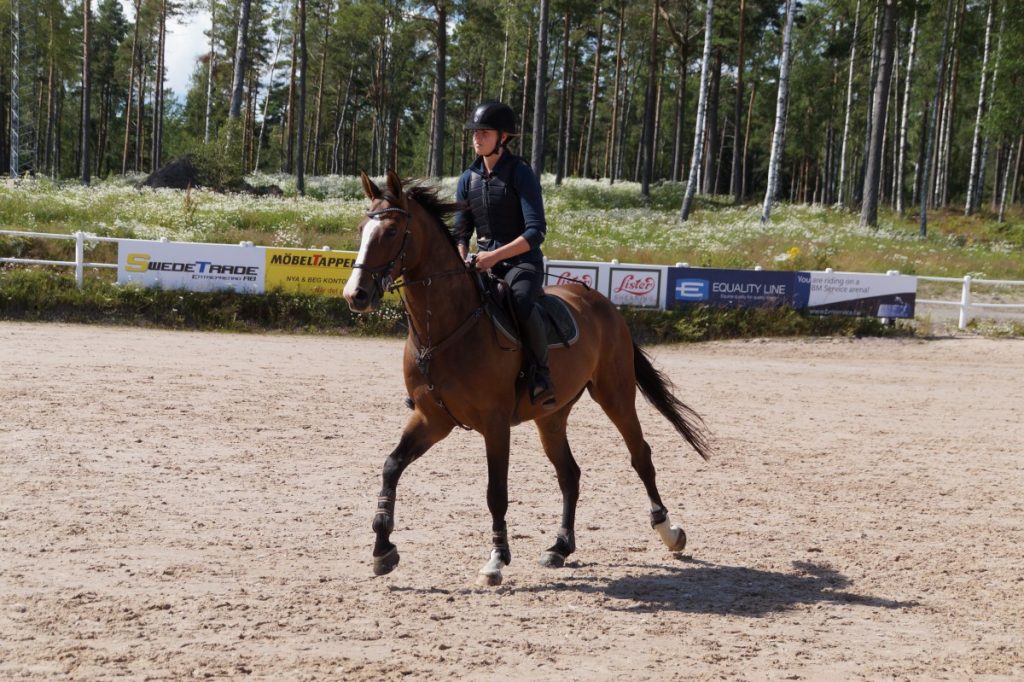No matter how well you take care of your horse, during the rainy season, rain rot is an issue that can affect even the most pristine of coats. You may find that your horse’s coat isn’t as shiny as it used to be or that its skin is rough and cracking. Even worse, its hair may have started falling out in clumps as you brush.
So, can you ride a horse with rain rot? No. You should not ride a horse with rain rot. Rain rot, at its worst, can be painful, and with rain rot mainly occurring on the back, riding your horse could cause more problems than it solves. It’s also highly contagious, spreading quickly to other animals and people. Luckily, rain rot can be remedied with proper grooming and attentive care.
In this article, you will learn what rain rot is, what causes it, why it’s best not to ride a horse with the infection, and how to remedy it and prevent it from occurring.
What is Rain Rot?
Rain rot is a bacterial condition that occurs whenever a horse is rained on, or its coat is left damp after a bath, and bacteria find their way inside an open wound or insect bite, resulting in an infection of the skin.
It’s most commonly found in horses during the spring and in horses that live in environments of high humidity or frequent rains. The condition can quickly spread from one area to another or from one horse to another via contact or by using infected grooming tools on a clean horse.
Mild cases of rain rot can cause:
- Loose hair on the coat
- Non-severe bald spotting
- Dry, flaking skin that is rough to the touch

Severe cases of rain rot can bring:
- Very thick scabbing
- Hair coming out in clumps or looking matted and unhealthy
- Scabs that don’t heal quickly and may have green or yellow pus
How to Spot Rain Rot in Your Horse
Rain rot is typically found on the back, shoulders, face, and flanks of a horse. This is because, when it rains, or the horse is bathed, these are the areas in which the water comes in most contact with. This infection can also occur in horses that have sweated under their saddle blankets and were left with a moist coat after being ridden without a sufficient means of drying off.
Rain rot is relatively easy to identify because it:
- Appears after a bout of heavy rains or exposure to high-moisture elements
- Presents itself in the same areas
- Has a consistent appearance
In all cases of rain rot in horses, there will be flaking of the skin, scabbing (may be mild or severe), and knotting of the coat. The area will also be tender to the touch and may cause flinching if you try to feel the infected skin.
Riding your horse with a bad case of rain rot will lead to quite a few issues, especially if any tack rubs against the sensitive area or if the rain rot is on the horse’s back. You should always refrain from tacking or riding your horse if you notice it’s experiencing discomfort.
Rain Rot Treatments
Once rain rot occurs, it can be difficult to remedy without veterinary intervention. You should never leave a case of rain rot to resolve on its own, as this could lead to more severe infection, spreading of the infection, and the spread of bacteria to your other animals.
Before treatment begins:
- Place your horse out in a sunny pasture so that its coat can dry completely.
- Avoid putting any dry blankets or coverings on it.
Veterinary treatment varies by case and is determined by the severity of the infection:
- If the infection isn’t severe and the horse is only showing signs of minor scabbing and hair matting, the treatment of rain rot will typically consist of:
- Brushing the coat thoroughly until the scabs are removed.
- Then, giving the horse an antimicrobial bath to wash the infected skin and kill bacteria.
- In severe cases, the horse will need to be groomed thoroughly, and removal of the scabs by hand will be necessary.
- Ensure that you’re wearing latex gloves when brushing or removing the scabs, as the bacteria can infect people as well and will enter the body through cuts on the hands.
- Additionally, use caution with your horse and be gentle, as the process will be painful, and the animal will likely react as such.
- Grooming and scab removal should be followed by a topical antibacterial treatment, along with antibiotics in extreme cases.
Once the scabs are removed, it’s recommended that you burn them to destroy the bacteria living in the infected skin. Remember that rain rot is highly contagious and will spread to both people and animals if not correctly disposed of. Therefore, you should separate the infected horse from the rest of the farm to avoid potential contamination.
Cleaning Contaminated Tack and Grooming Gear
Because the bacteria from rain rot can fester on the brushes, saddle pads, and tack, you must wash all items that have been exposed to the infected horse thoroughly. It’s best to use antibacterial soap and boiling water and allow the grooming gear and tack to soak, if possible.
Refrain from using the brushes, saddle blankets, or other gear for horses that aren’t infected with rain rot. Once the gear is cleaned, place the items out in the sun to kill off any remaining bacterium and dry.
How to Prevent Rain Rot From Occurring
To keep your horse happy, healthy, and free of rain rot, there are a few things you should do:
- Because rain rot is a condition that occurs whenever moisture is trapped on a horse’s coat, you must remove blankets every few days to allow the skin to be exposed to the sun and air.
- Daily grooming will help to remove any built-up moisture or mud and dislodge matted hair that could be trapping bacteria.
- Check your horse often for cuts and address them. Addressing a cut will help solve rain rot before it even begins. Clean the cut to kill any existing bacteria.
- Keep your horse out of the rain whenever possible. You never want to keep a horse cooped up in the barn, but when a big storm is coming, it’s best to put your horse in a dry environment.
- Don’t ride your horse directly after a rain (that it’s been exposed to) or a bath. Trapping the moisture underneath the saddle blanket and tack will encourage bacteria to grow.
- Remove tack immediately from a sweating horse after riding. This will cut the time that your horse’s coat is exposed to moisture and allow its back to air out and dry from the sweat.
- Use an insect repellent on your horse’s coat to discourage bites and scratching. Bug bites and the cuts that result in nipping at or scratching them will encourage bacteria to move into these skin imperfections and multiply. A good insect repellent, like this one, can prevent bugs from coming near your horse.
Final Thoughts
Though riding your horse is a fun way to pass the time and bond with an animal, it’s best to avoid riding a horse that is infected with rain rot. Rain rot can be a painful condition for horses and occurs after heavy rains or wherever there is moisture that can be trapped on the surface of a horse’s skin. Always address rain rot whenever you see it developing and remember that the best way to treat rain rot is not to let your horse get it in the first place!
Sources:
